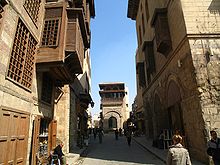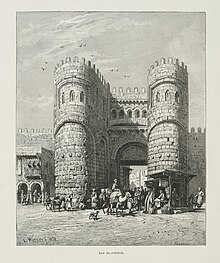al-Muizz Street
The al-Muizz Street ( Arabic شارع المعز, DMG Šāriʿ al-Muʿizz orشارع المعز لدين الله, DMG Šāriʿ al-Muʿizz li-Dīn Allāh ) in Cairo was the main street of the city in the Middle Ages and formed the center during the rule of the Ismaili dynasty of the Fatimids . It is named after the imam and fourth caliph of the Fatimid dynasty al-Muizz li-Din Allah , who moved the capital of the empire from al-Mahdiya to Cairo in 972 .




The street in the medieval district of Cairo, the capital of Egypt, is over a kilometer long and is one of the oldest streets in the city. It extends from the Bab al-Futuh , the gate of the Fatimid city fortifications in the north, to the Bab Zuweila , the gate in the south. According to a study by the United Nations , it has the greatest concentration of medieval architectural treasures in the Islamic world. Starting in 1997, the Egyptian government carried out extensive renovation work on the historic and modern buildings, the paving and sewerage in order to convert the street into an open-air museum of Islamic architecture .
Muizz Street is generally considered to be divided into two sections, with al-Azhar Street (Shariʿ al-Azhar) as the center line. The northern part extends from the al-Hakim mosque in the north to the Khan el-Khalili bazaar and the spice dealers' market on al-Azhar Street and includes the section with the antique markets, the al-Aqmar mosque (one of the few surviving Fatimid - mosques ) and the Qalawoon complex and several well-preserved medieval mansions and palaces.
The southern part extends from the Ghuriya complex to Bab Zuweila , the gate in the south, and includes the tent makers' bazaar in the Gamaliya district.
Historical buildings
In the area around al-Muizz Street and on the main street itself, there are many historical buildings that stretch from the time of the Fatimids , Ayyubids , Mamluks , Ottomans to the Muhammad Ali era.
From the north of Muizz-Straße towards the south there are the following buildings on the street or in its vicinity today (see also overview maps):
- Mosque of al-Hakim bi Amr Allah (1013)
- Wikala des Qaytbay (1481)
- Mausoleum of Ahmad al-Qazid (1335)
- Wikala of the Qawsum (1330)
- Sabil-Kuttab of Oda Baschi (1673)
- Abu Bakr Muzhir Mosque (1480)
- Mosque of Sulayman al-Agha Silihdar (1839)
- Bayt al-Suhaymi (1648–1796)
- Sabil Qitas (1630)
- Chanqah of Baybar al-Gashankir (1310)
- al-aqmar mosque (1125)
- Qarasunqur Madrasa (1300)
- Sabil-Kuttab and Wikala des Dhu'l Fiqar (1673)
- Sabil-Kuttab of Abdel Rahman Katchuda (1744)
- Mosque of Gamal al-Din Ustadar (1407)
- Musafirchana Palace (1788)
- Qasr Bashtak (1339)
- Madrasa of Amir Mithqal (1363)
- Mosque of Mahmoud Muharram (1792)
- Sabil of Ismail Pasha (1828)
- Madrasah of al-Kamil Ayyub (1229)
- Madrasa of Barquq (1386)
- Madrasa Tatar al-Higaziya (1348)
- Qa'a of al-Muwaqqi (1350)
- Madrasah of al-Nasir Muhammad (1304)
- Qalawun Complex (1285)
- Maq'ad des Mamay al-Sayfi (1496)
- Taghri Bardi Mosque (1440)
- Sabil-Kuttab of Chusraw Pasha (1535)
- Madrasa of al-Salih Ayyb (1250)
- Sabila-Kuttab Ali Ibn Hayz (1646)
- Wikala of Gamal al-Din al-Dhahabi (1637)
- Sabil-Kuttab of Ahmad Pasha (1864)
- Mosque of al-Sayyidna Husseyn (1154)
- Wikala of Sulayman al-Agha Silihdar (1838)
In the southern part of Muizz Street in the area after the intersection with Al-Azhar Street are the following historical buildings:
- Mosque of al-Ashraf Barsbay (1425)
- Sheikh Ali al-Mutahhar's mosque (1744)
- Al-Azhar Mosque (970)
- Abu Dahab Mosque (1774)
- Madrasa of Sultan al-Ghuri (1505)
- Mausoleum of Sultan al-Ghuri (1505)
- Wikala of al-Ghuri (1505)
- Sabil-Kuttab and Wikala of Qaytbay (1477)
- House of Zaynab Hatun (1713)
- House of Sitt Wasila (1664)
- House of al-Haraw (1731)
- Al-Ayni Mosque (1411)
- House of Gamal al-Din al-Dhahabi (1634)
- Fakahani Mosque (1735)
- Sabil des Tosun Pasha (1820)
- Muayyad Mosque (1420)
- Wikala and Sabil by Nafisa Bayda (1796)
- Takiya of al-Gulschani (1524)
- Zawiya of Farag Ibn Barquq (1408)
- Salih Tala'i Mosque (1160)
UNESCO world heritage
The ensemble of Islamic architecture in the Islamic old town of Cairo ( Islamic Cairo ) was included in the list of world cultural heritage by UNESCO in 1979 .
Historical Cairo rehabilitation project
Much of the 850-million Egyptian pound -Project Historic Cairo Rehabilitation Project ( HCRP ) was Muizz-al-Straße spent on the restoration of the 34 monuments listed on the 67 and other Islamic buildings in neighboring streets.
literature
- Nicholas Warner: The monuments of historic Cairo: a map and descriptive catalog. American University at Cairo Press, Cairo; New York ISBN 977-424-841-4 ( American Research Center in Egypt Conservation Series 1)
- Caroline Williams: Islamic Monuments in Cairo: The Practical Guide . 2002 ( excerpt a in Google Book Search, b in Google Book Search)
Web links
- alrahalah.com: AL-MU'IZZ STREET - CAIRO'S GRAND STREET
- english.ahram.org.eg: Cairo's historic Al-Muizz street slowly regaining its allure
- articles.latimes.com: Once-Splendid Medieval Cairo Crumbles Into Ruins & Cairo Tries to Reclaim Lost Treasure Amid City's Trash ( Los Angeles Times )
- mondoarc.com: Share 'Al-Muiz, Cairo, Egypt
References and footnotes
- ↑ Los Angeles Times . July 10, 1998. Cairo Tries to Reclaim Lost Treasure Amid City's Trash. ("The richest trove of medieval Islamic architecture in the world")
- ↑ Los Angeles Times . Sep 28, 1997. Once-Splendid Medieval Cairo Crumbles Into Ruins.
- ^ Whc.unesco.org: Historic Cairo
- ↑ Saving a landmark of Islamic Cairo ( Memento from September 11, 2011 in the Internet Archive ): "A large share of the LE 850-million HCRP project has been spent on restoring the 34 listed monuments on Al-Muizz Street and a further 67 Islamic edifices in neighboring alleyways. "
Coordinates: 30 ° 3 ′ 19.9 ″ N , 31 ° 15 ′ 48.3 ″ E




